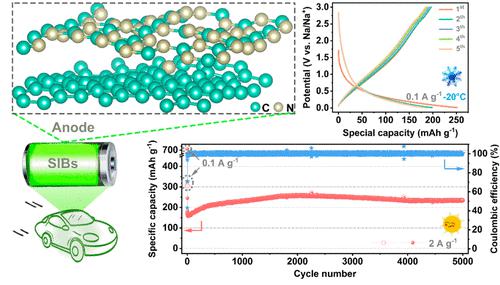Our official English website, www.x-mol.net, welcomes your
feedback! (Note: you will need to create a separate account there.)
Highly Crystalline Poly(heptazine imide)-Based Carbonaceous Anodes for Ultralong Lifespan and Low-Temperature Sodium-Ion Batteries
ACS Nano ( IF 15.8 ) Pub Date : 2024-01-16 , DOI: 10.1021/acsnano.3c10779 Ying Wang 1, 2, 3 , Hongguan Li 1, 2, 3 , Boyin Zhai 4 , Xinglong Li 4 , Ping Niu 1, 2, 3 , Jérémy Odent 5 , Shulan Wang 4 , Li Li 1, 2, 3
ACS Nano ( IF 15.8 ) Pub Date : 2024-01-16 , DOI: 10.1021/acsnano.3c10779 Ying Wang 1, 2, 3 , Hongguan Li 1, 2, 3 , Boyin Zhai 4 , Xinglong Li 4 , Ping Niu 1, 2, 3 , Jérémy Odent 5 , Shulan Wang 4 , Li Li 1, 2, 3
Affiliation

|
Carbon nitrides with layered structures and scalable syntheses have emerged as potential anode choices for the commercialization of sodium-ion batteries. However, the low crystallinity of materials synthesized through traditional thermal condensation leads to insufficient conductivity and poor cycling stability, which significantly hamper their practical applications. Herein, a facile salt-covering method was proposed for the synthesis of highly ordered crystalline C3N4-based all-carbon nanocomposites. The sealing environment created by this strategy leads to the formation of poly(heptazine imide) (PHI), the crystalline phase of C3N4, with extended π-conjugation and a fully condensed nanosheet structure. Meanwhile, theoretical calculations reveal the high crystallinity of C3N4 significantly reduces the energy barrier for electron transition and enables the generation of efficient charge transfer channels at the heterogeneous interface between carbon and C3N4. Accordingly, such nanocomposites present ultrastable cycling performances over 5000 cycles, with a high reversible capacity of 245.1 mAh g–1 at 2 A g–1 delivered. More importantly, they also exhibit an outstanding low-temperature capacity of 196.6 mAh g–1 at −20 °C. This work offers opportunities for the energy storage use of C3N4 and provides some clues for developing long-life and high-capacity anodes operated under extreme conditions.
中文翻译:

用于超长寿命和低温钠离子电池的高结晶聚(庚嗪酰亚胺)基碳质阳极
具有层状结构和可扩展合成的氮化碳已成为钠离子电池商业化的潜在阳极选择。然而,传统热缩聚合成的材料结晶度低,导致导电率不足和循环稳定性差,严重阻碍了其实际应用。在此,提出了一种简便的盐覆盖方法来合成高度有序的结晶C 3 N 4基全碳纳米复合材料。通过该策略创建的密封环境导致形成聚七嗪酰亚胺(PHI),即C 3 N 4的结晶相,具有扩展的π共轭和完全凝聚的纳米片结构。同时,理论计算表明,C 3 N 4的高结晶度显着降低了电子跃迁的能垒,使得能够在碳和C 3 N 4之间的异质界面处产生有效的电荷转移通道。因此,此类纳米复合材料呈现出超过 5000 次循环的超稳定循环性能,在 2 A g –1电流下具有 245.1 mAh g –1的高可逆容量。更重要的是,它们还表现出-20°C 时 196.6 mAh g –1的出色低温容量。这项工作为C 3 N 4的储能应用提供了机会,并为开发在极端条件下运行的长寿命和高容量阳极提供了一些线索。
更新日期:2024-01-16
中文翻译:

用于超长寿命和低温钠离子电池的高结晶聚(庚嗪酰亚胺)基碳质阳极
具有层状结构和可扩展合成的氮化碳已成为钠离子电池商业化的潜在阳极选择。然而,传统热缩聚合成的材料结晶度低,导致导电率不足和循环稳定性差,严重阻碍了其实际应用。在此,提出了一种简便的盐覆盖方法来合成高度有序的结晶C 3 N 4基全碳纳米复合材料。通过该策略创建的密封环境导致形成聚七嗪酰亚胺(PHI),即C 3 N 4的结晶相,具有扩展的π共轭和完全凝聚的纳米片结构。同时,理论计算表明,C 3 N 4的高结晶度显着降低了电子跃迁的能垒,使得能够在碳和C 3 N 4之间的异质界面处产生有效的电荷转移通道。因此,此类纳米复合材料呈现出超过 5000 次循环的超稳定循环性能,在 2 A g –1电流下具有 245.1 mAh g –1的高可逆容量。更重要的是,它们还表现出-20°C 时 196.6 mAh g –1的出色低温容量。这项工作为C 3 N 4的储能应用提供了机会,并为开发在极端条件下运行的长寿命和高容量阳极提供了一些线索。


















































 京公网安备 11010802027423号
京公网安备 11010802027423号